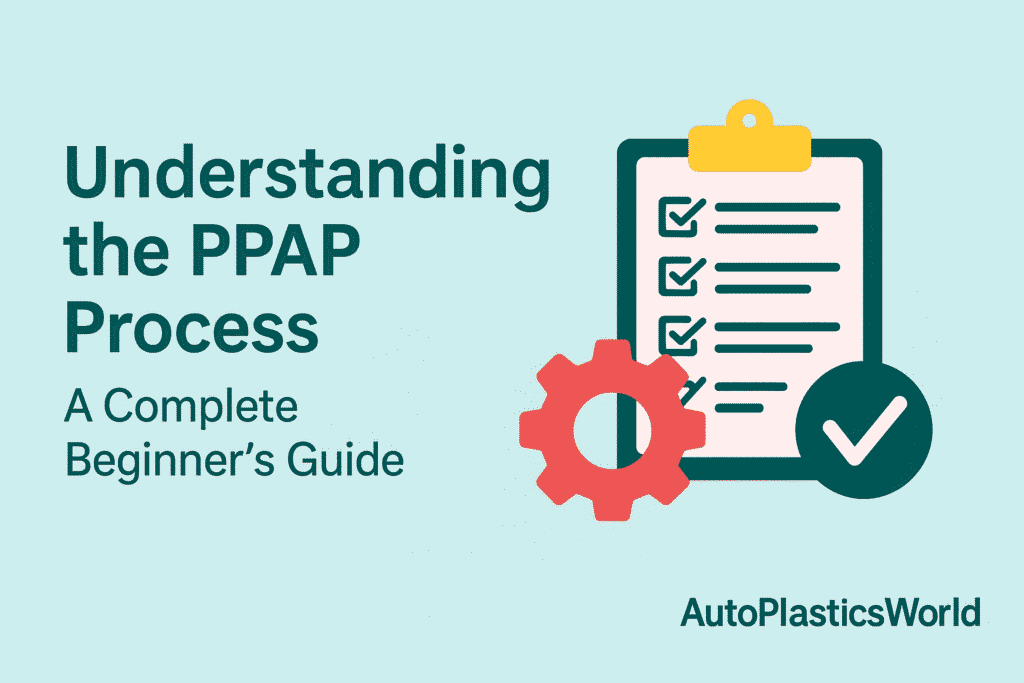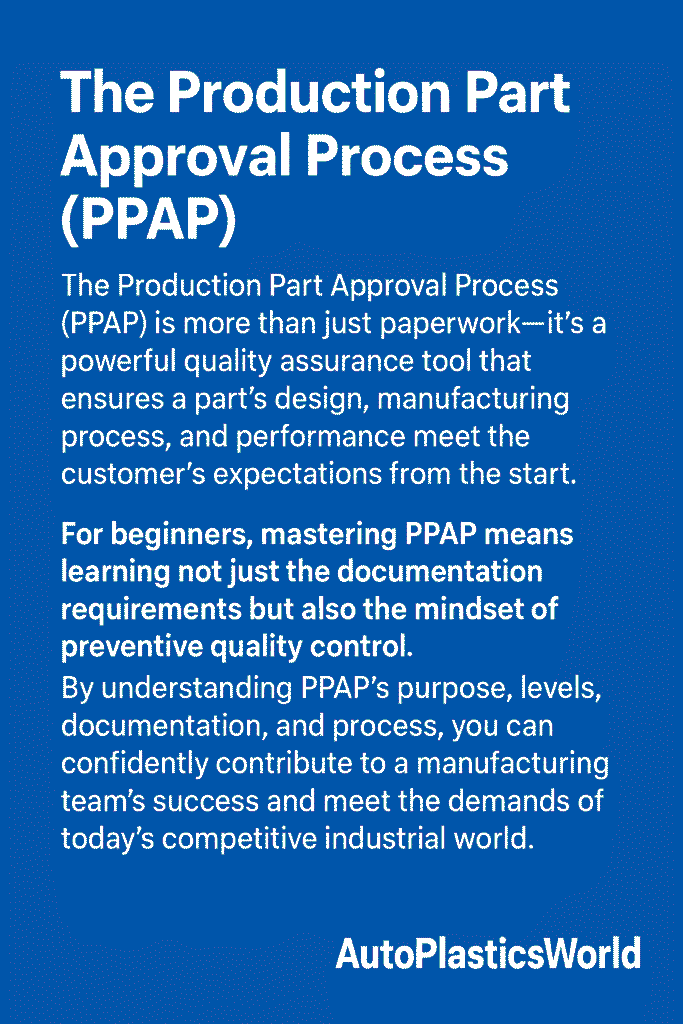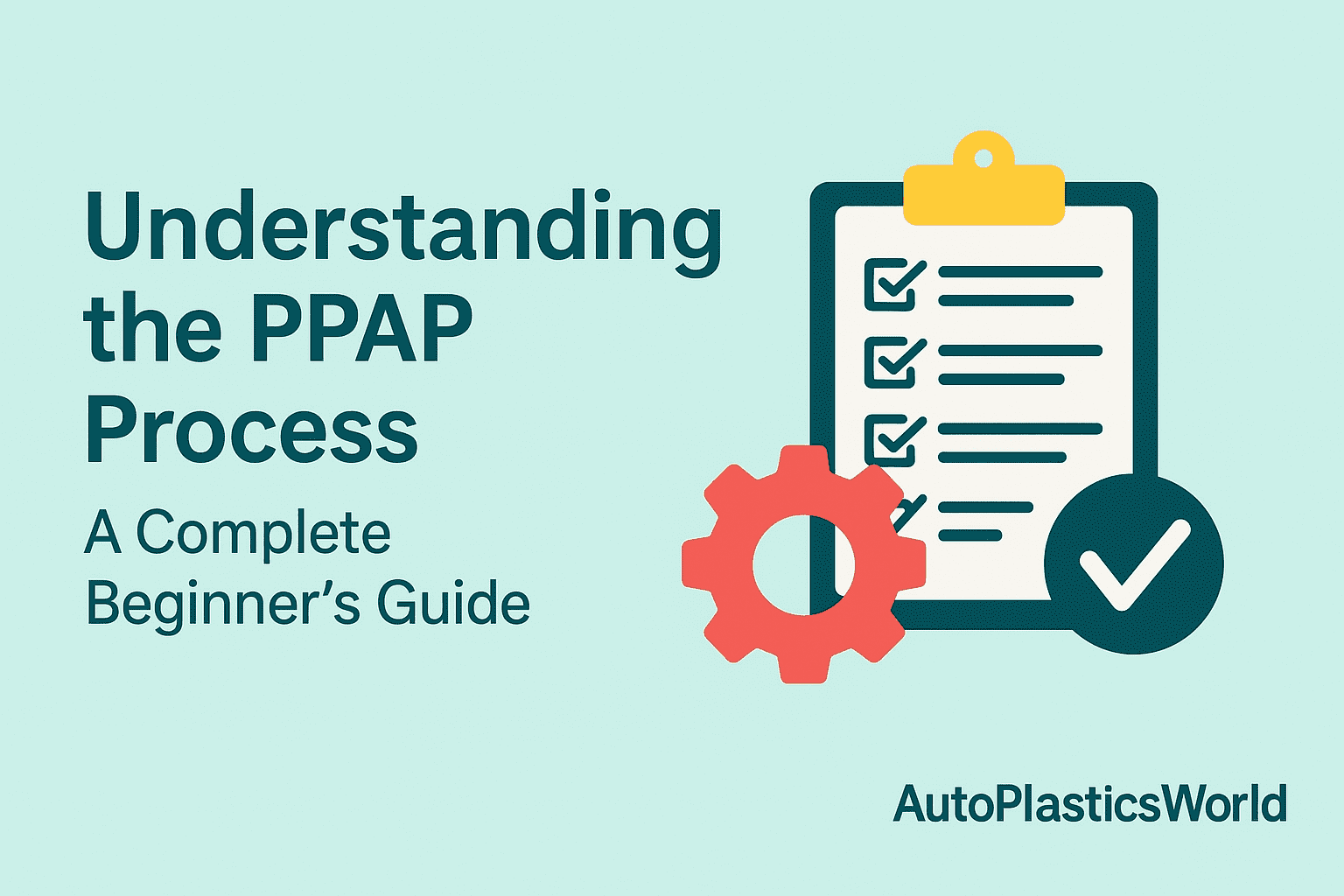In the world of manufacturing—especially in the automotive, aerospace, and industrial sectors—quality and consistency are non-negotiable. A product that fails to meet specifications can cause not just financial losses but also reputational damage, safety risks, and production delays. To prevent such issues, industries follow well-defined quality approval processes.
One of the most widely recognized methods in automotive manufacturing is the Production Part Approval Process (PPAP). This structured process ensures that every new or modified part meets the customer’s requirements before it goes into full production.
If you’re new to the manufacturing or quality field, this guide will give you a complete, beginner-friendly understanding of PPAP—its purpose, levels, elements, process steps, documentation, and best practices.

What is PPAP?
PPAP stands for Production Part Approval Process. It is a standardized process used primarily in the automotive industry (but also in aerospace, medical devices, and industrial sectors) to ensure that the supplier understands all engineering design specifications and that the production process consistently produces parts meeting those specifications.
It is a requirement of the APQP (Advanced Product Quality Planning) methodology and is part of the IATF 16949 standard for automotive quality management systems.
Purpose of PPAP
The main goals of PPAP are:
- Verify supplier capability: Confirm that a supplier can meet the customer’s engineering and quality requirements.
- Ensure repeatability: Prove that the manufacturing process can consistently produce conforming parts under actual production conditions.
- Document the process: Create a traceable record showing the part’s compliance with all requirements.
- Reduce risk: Identify and address potential production issues before full-scale manufacturing.
- Customer confidence: Provide assurance to the OEM (Original Equipment Manufacturer) that parts meet agreed-upon standards.

When is PPAP Required?
PPAP is generally required in situations such as:
- Launch of a new part or product.
- Changes to design specifications.
- Changes in production process, methods, or location.
- Changes in material or suppliers.
- Resumption of production after a prolonged shutdown.
- When requested by the customer.
PPAP Levels of Submission
PPAP has five submission levels based on the amount of documentation and evidence the customer needs.
| Level | Description | When Used |
|---|---|---|
| Level 1 | Part Submission Warrant (PSW) only. | For very simple changes or low-risk situations. |
| Level 2 | PSW with product samples and limited supporting data. | When moderate risk is involved. |
| Level 3 | Part Submission Warrant with product samples and complete supporting data. | Most common level used in automotive PPAP. |
| Level 4 | Part Submission Warrant & other requirements as defined by customer. | Special cases where custom documentation is needed. |
| Level 5 | Part Submission Warrant with product samples & complete supporting data available for review at the supplier’s manufacturing location. | For critical parts or when maximum verification is needed. |
The 18 PPAP Elements (Documentation Requirements)
A Level 3 PPAP submission typically includes 18 key elements. Understanding these is crucial for any beginner:
- Design Records – Engineering drawings or CAD files defining the part.
- Authorized Engineering Change Documents – Records of any approved design changes.
- Engineering Approval – Any required approval from the customer engineering team.
- Design Failure Mode and Effects Analysis (DFMEA) – Document analyzing possible design failures and preventive measures.
- Process Flow Diagram – Step-by-step diagram of the manufacturing process.
- Process Failure Mode and Effects Analysis (PFMEA) – Risk analysis for potential failures in the production process.
- Control Plan – Detailed plan outlining controls at each step to ensure quality.
- Measurement System Analysis (MSA) – Verification that measurement tools are accurate and repeatable.
- Dimensional Results – A report of measurements showing part dimensions meet specifications.
- Material, Performance Test Results – Data proving the material meets requirements.
- Initial Process Studies (SPC) – Statistical process control data showing process stability.
- Qualified Laboratory Documentation – Proof that any testing was done by accredited labs.
- Appearance Approval Report (AAR) – For parts where appearance matters (color, texture, etc.).
- Sample Production Parts – Physical samples from the actual production run.
- Master Sample – The reference sample kept at both supplier and customer site.
- Checking Aids – Gauges, fixtures, or tools used for inspection.
- Customer-Specific Requirements – Any extra documents required by the OEM.
- Part Submission Warrant (PSW) – Summary document certifying that all PPAP requirements have been met.
PPAP Process Steps
Here’s the typical flow for a PPAP process:
Step 1 – Review Requirements
- Understand customer-specific PPAP submission level.
- Review design specifications, CAD models, and quality standards.
Step 2 – Prepare Documentation
- Create DFMEA, PFMEA, Process Flow Diagram, and Control Plan.
- Collect dimensional and test results.
- Prepare MSA and SPC studies.
Step 3 – Produce Initial Samples
- Manufacture a limited run under normal production conditions.
- Record data and measure all parameters.
Step 4 – Submit PPAP Package
- Assemble all 18 PPAP elements as required by the submission level.
- Submit to customer for review.
Step 5 – Customer Review & Approval
- Customer reviews documents and parts.
- Approval, interim approval, or rejection is given.
PPAP Status Types
When the customer reviews your PPAP submission, you’ll receive one of these statuses:
- Approved – You can proceed with full production.
- Interim Approval – Temporary approval with conditions (usually for a limited quantity).
- Rejected – Your process or part does not meet requirements; corrections are needed.
Common Mistakes Beginners Make in PPAP
- Submitting incomplete documents or missing elements.
- Using outdated design records or control plans.
- Not performing actual production run for samples.
- Incorrect measurement system analysis data.
- Poor communication with the customer on requirements.
Best Practices for Successful PPAP
- Start early – Don’t wait until the deadline to prepare documents.
- Cross-functional teamwork – Involve design, production, and quality teams from the start.
- Follow customer-specific requirements – Every OEM has its own PPAP guidelines.
- Keep records updated – Ensure all documents match the latest design revisions.
- Use templates and checklists – Avoid missing any required element.
Why PPAP Matters in Manufacturing Careers?
If you are starting a career in manufacturing—whether in quality control, process engineering, or supply chain management—understanding PPAP will set you apart. It’s a fundamental skill for working with OEMs and Tier-1 suppliers, especially in the automotive sector.
Key benefits:
- Improves your professional credibility.
- Makes you more employable in global manufacturing industries.
- Helps in effective supplier-customer communication.
Frequently Asked Questions (FAQ) about PPAP
Why is PPAP important in manufacturing?
PPAP ensures consistency, quality, and compliance with customer expectations. It helps identify and resolve potential issues early, reducing costly rework or product recalls.
Who uses the PPAP process?
PPAP is widely used in automotive, aerospace, and industrial manufacturing industries by suppliers, manufacturers, and quality engineers to meet customer-specific requirements.
What documents are included in a PPAP package?
A PPAP package may contain up to 18 required elements, such as:
- Design Records
- Process Flow Diagram
- PFMEA (Process Failure Mode and Effects Analysis)
- Control Plan
- Measurement System Analysis (MSA)
- Initial Process Studies (SPC)
- Part Submission Warrant (PSW)
What happens if a PPAP is rejected?
If a PPAP is rejected, the supplier must correct the issues, update documentation, or adjust the manufacturing process before resubmitting for approval.
Can PPAP be used outside the automotive industry?
Yes. While PPAP originated in automotive manufacturing, its principles are also applied in medical devices, aerospace, electronics, and heavy equipment manufacturing for quality assurance.
How can beginners learn PPAP effectively?
Beginners can learn PPAP by:
- Studying AIAG PPAP manuals
- Attending quality management training
- Working with experienced engineers
- Reviewing real PPAP documentation examples
Conclusion
The Production Part Approval Process (PPAP) is more than just paperwork—it’s a powerful quality assurance tool that ensures a part’s design, manufacturing process, and performance meet the customer’s expectations from the start.
For beginners, mastering PPAP means learning not just the documentation requirements but also the mindset of preventive quality control. By understanding PPAP’s purpose, levels, documentation, and process, you can confidently contribute to a manufacturing team’s success and meet the demands of today’s competitive industrial world.


I don’t usually comment but I gotta tell thankyou for the post on this special one : D.
Merely wanna comment on few general things, The website style is perfect, the written content is rattling great. “By following the concept of ‘one country, two systems,’ you don’t swallow me up nor I you.” by Deng Xiaoping.